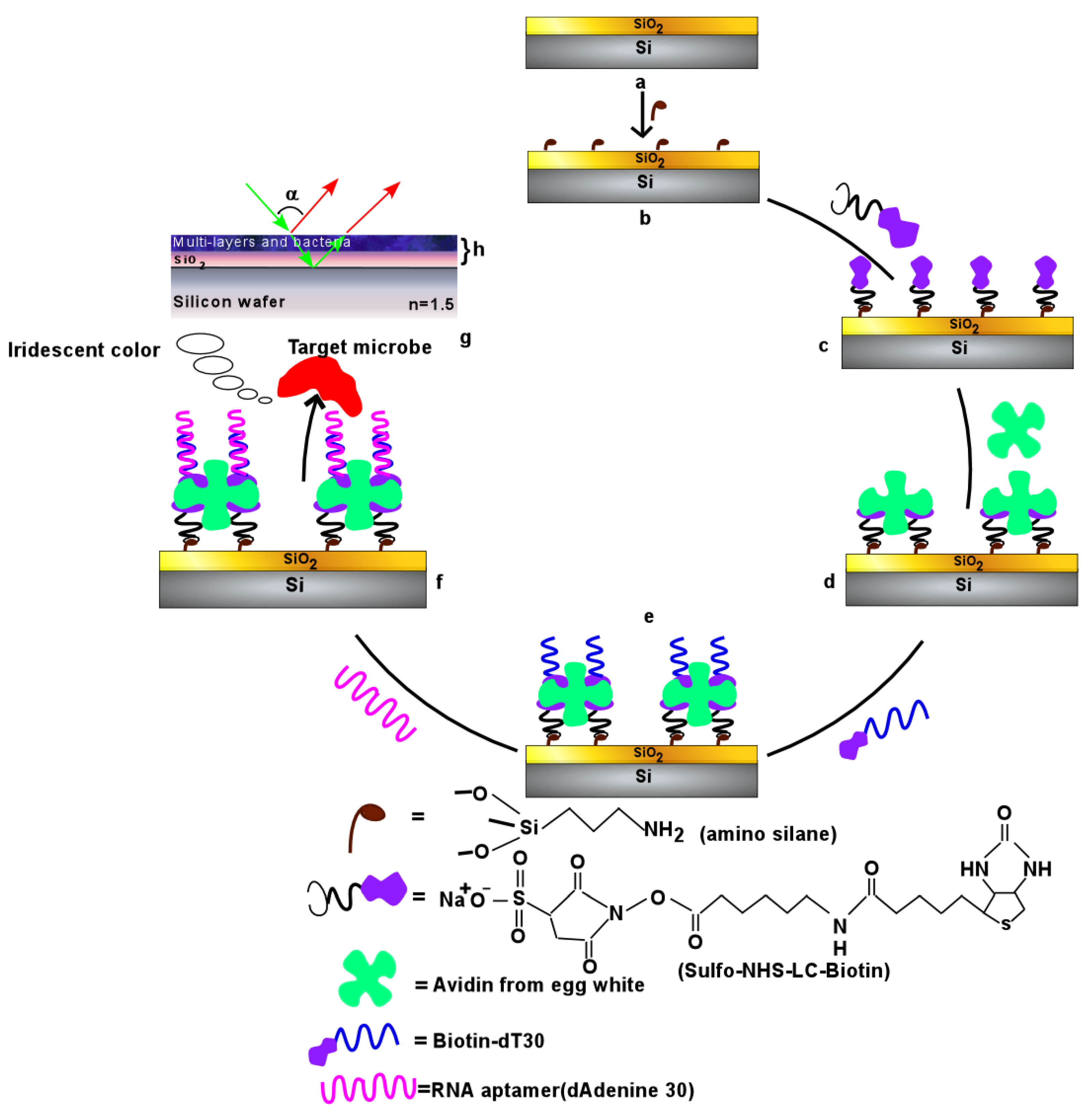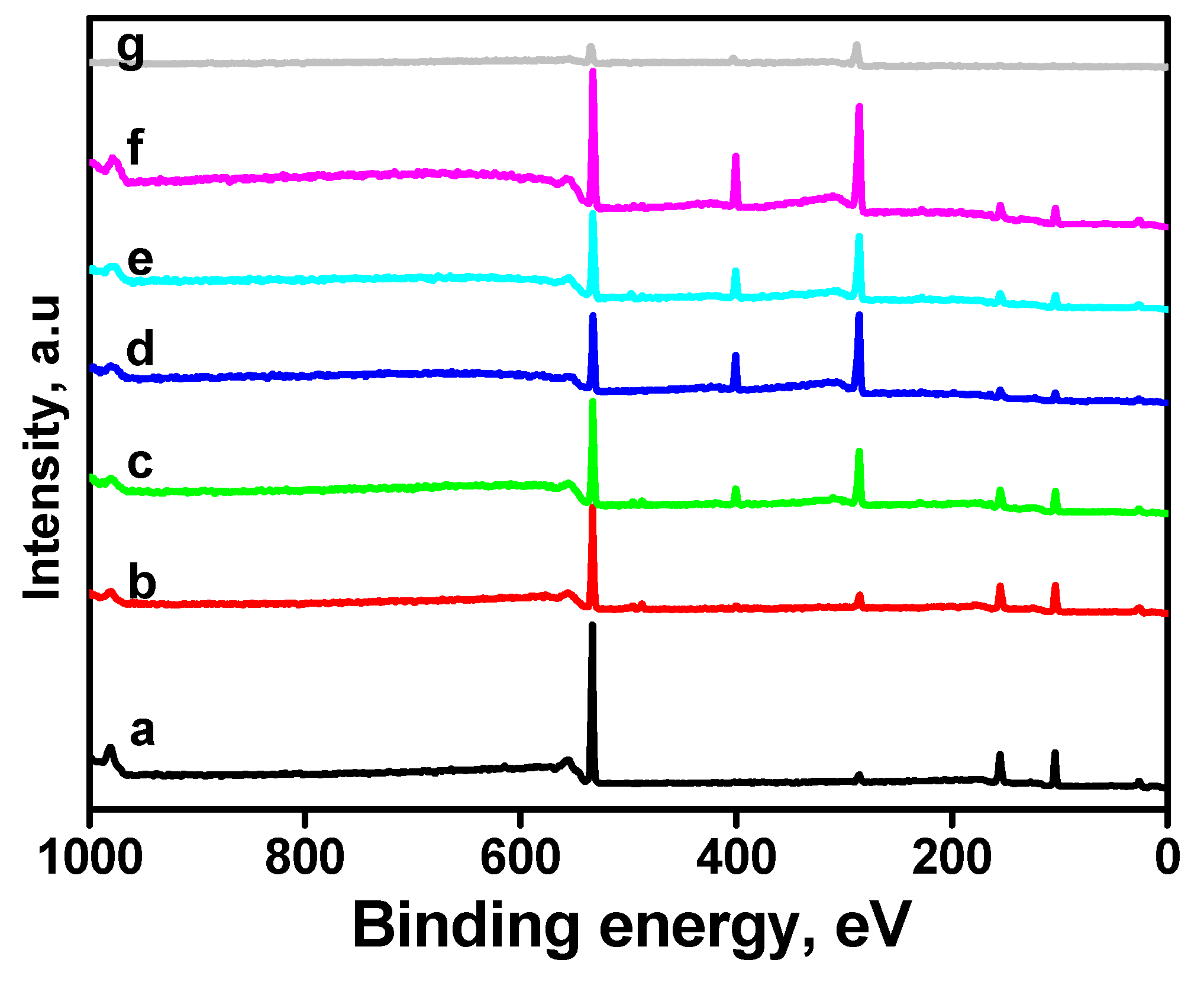Design and Fabrication of Biosensor for a Specific Microbe by Silicon-Based Interference Color System
Abstract
:1. Introduction
2. Materials and Methods
2.1. Surface Preparation
2.2. Surface Characterization
2.2.1. X-ray Photoelectron Spectroscopy (XPS)
2.2.2. Atomic Force Microscopy (AFM)
2.2.3. UV-Vis Reflectance Spectrophotometry
3. Results and Discussion
3.1. Surface Analysis by XPS
3.2. Aptamer Chip Binding with Microbe
4. Conclusions
Author Contributions
Funding
Data Availability Statement
Acknowledgments
Conflicts of Interest
References
- Kulagina, N.V.; Lassman, M.E.; Ligler, F.S.; Taitt, C.R. Antimicrobial peptides for detection of bacteria in biosensor assays. Anal. Chem. 2005, 77, 6504. [Google Scholar] [CrossRef] [PubMed]
- McCauley, T.G.; Hamaguchi, N.; Stanton, M. Aptamer-based biosensor arrays for detection and quantification of biological macromolecules. Anal. Biochem. 2003, 319, 244–250. [Google Scholar] [CrossRef]
- Kinoshita, T.; Hayashi, S.; Yokogawa, Y. Preparation of a structural color forming system by polypeptide-based LB films. J. Photochem. Photobiol. A Chem. 2001, 145, 101. [Google Scholar] [CrossRef]
- Ostroff, R.M.; Hopkins, D.; Haeberli, A.B.; Baouchi, W.; Polisky, B. Thin film biosensor for rapid visual detection of nucleic acid targets. Clin. Chem. 1999, 45, 1659–1664. [Google Scholar] [CrossRef] [PubMed]
- Hayashi, S.; Yokogawa, Y.; Kinoshita, T. LB deposition of a stearic acid multilayer without heavy metals. Bull. Chem. Soc. Jpn. 2002, 75, 867–870. [Google Scholar] [CrossRef]
- Tominaga, R.; Sivakumar, M.; Kobayashi, T.; Kinoshita, T. Construction and Estimation of Inorganic~Organic Nanostructured Sensing Plate. Trans. Mater. Res. Soc. Jpn. 2005, 30, 349–352. [Google Scholar]
- Madhu, M.; Santhoshkumar, S.; Tseng, W.-B.; Tseng, W.-L. Optical Nanoprobes for Aminothiols Sensing in Real-World Samples. Sens. Actuators Rep. 2022, 4, 100123. [Google Scholar] [CrossRef]
- Takeuchi, M.; Hamana, K.; Hiraishi, A. Proposal of the genus Sphingomonas sensu stricto and three new genera, Sphingobium, Novosphingobium and Sphingopyxis, on the basis of phylogenetic and chemotaxonomic analyses. Int. J. Syst. Evol. Microbiol. 2001, 51, 1405–1417. [Google Scholar] [CrossRef] [PubMed]
- Madhu, M.; Santhoshkumar, S.; Tseng, W.-B.; Santhana Krishna Kumar, A.; Tseng, W.-L. Synthesis of rhenium disulfide nanodots exhibiting pH-dependent fluorescence and phosphorescence for anticounterfeiting and hazardous gas detection. Spectrochimica Acta Part A, 2024; 315, 124240. [Google Scholar]
- Sivakumar, M.; Tominaga, R.; Koga, T.; Kinoshita, T.; Sugiyama, M.; Yamaguchi, K. Studies on visual sensor from self-assembled polypeptides. Sci. Technol. Adv. Mater. 2005, 6, 91. [Google Scholar] [CrossRef]
- Castelino, K.; Kannan, B.; Majumdar, A. Characterization of Grafting Density and Binding Efficiency of DNA and Proteins on Gold Surfaces. Langmuir 2005, 21, 1956–1961. [Google Scholar] [CrossRef]
- Riepl, M.; Enander, K.; Liedberg, B.; Schaeferling, M.; Kruschina, M.; Ortigao, F. Functionalized surfaces of mixed alkanethiols on gold as a platform for oligonucleotide microarrays. Langmuir 2002, 18, 7016. [Google Scholar] [CrossRef]
- Dill, K.; Stanker, L.H.; Young, C.R. Detection of salmonella in poultry using a silicon chip-based biosensor. J. Biochem. Biophys. Methods 1999, 41, 61–67. [Google Scholar] [CrossRef] [PubMed]
- Midwood, K.S.; Carolus, M.D.; Danahy, M.P.; Schwarzbauer, J.E.; Schwartz, J. Easy and efficient bonding of biomolecules to an oxide surface of silicon. Langmuir 2004, 20, 5501. [Google Scholar] [CrossRef] [PubMed]
- Howe, E.; Harding, G. A comparison of protocols for the optimization of detection of bacteria using a surface acoustic wave (SAW) biosensor. Biosens. Bioelectron. 2000, 15, 641–649. [Google Scholar] [CrossRef] [PubMed]
- Sigal, G.B.; Bamdad, C.; Barberis, A.; Strominger, J.; Whitesides, G.M. Arrays of self-assembled monolayers for studying inhibition of bacterial adhesion. Anal. Chem. 1996, 68, 490. [Google Scholar] [CrossRef] [PubMed]
- Harper, W.J. The Strengths and Weaknesses of the Electronic Nose. In Headspace Analysis of Foods and Flavors; Rouseff, R., Cadwallader, K., Eds.; Springer: New York, NY, USA, 2001; Volume 488, pp. 59–71. [Google Scholar]
- Madhu, M.; Santhoshkumar, S.; Tseng, W.-B.; Tseng, W.-L. Maximizing analytical precision: Exploring the advantages of ratiometric strategy in fluorescence, Raman, electrochemical, and mass spectrometry detection. Front. Anal. Sci. 2023, 3, 1258558. [Google Scholar] [CrossRef]
- Rozlosnik, N.; Gerstenberg, M.C.; Larsen, N.B. Effect of Solvents and Concentration on the Formation of a Self-Assembled Monolayer of Octadecylsiloxane on Silicon (001). Langmuir 2003, 19, 1182–1188. [Google Scholar] [CrossRef]
- Davis, D.H.; Giannoulis, C.S.; Johnson, R.W.; Desai, T.A. Immobilization of RGD to <1 1 1> silicon surfaces for enhanced cell adhesion and proliferation. Biomaterials 2002, 23, 4019–4027. [Google Scholar] [PubMed]
- Beamson, G.; Briggs, D. High Resolution XPS of Organic Polymers: The Scienta ESCA300 Database; John Wiley & Sons: New York, NY, USA, 1992. [Google Scholar]
- Porté-Durrieu, M.C.; Labrugère, C.; Villars, F.; Lefebvre, F.; Dutoya, S.; Guette, A.; Bordenave, L. Development of RGD peptides grafted onto silica surfaces: XPS characterization and human endothelial cell interactions. J. Biomed. Mater. Res. 1999, 46, 368. [Google Scholar] [CrossRef]
- Xia, N.; Hu, Y.; Grainger, D.W.; Castner, D.G. Functionalized poly (ethylene glycol)-grafted polysiloxane monolayers for control of protein binding. Langmuir 2002, 18, 3255–3262. [Google Scholar] [CrossRef]
- Xiao, S.J.; Textor, M.; Spencer, N.D.; Wieland, M.; Keller, B.; Sigrist, H. Immobilization of the cell-adhesive peptide Arg–Gly–Asp–Cys (RGDC) on titanium surfaces by covalent chemical attachment. J. Mater. Sci. Mater. Med. 1997, 8, 867. [Google Scholar] [CrossRef] [PubMed]
- Castner, D.; Hinds, K.; Grainger, D. X-ray photoelectron spectroscopy sulfur 2p study of organic thiol and disulfide binding interactions with gold surfaces. Langmuir 1996, 12, 5083. [Google Scholar] [CrossRef]
- Kumar, A.S.K.; Tseng, W.-B.; Wu, M.-J.; Huang, Y.-Y.; Tseng, W.-L. L-Cystine-Linked BODIPY-Adsorbed Monolayer MoS2 Quantum Dots for Ratiometric Fluorescent Sensing of Biothiols Based on the Inner Filter Effect. Anal. Chim. Acta 2020, 1113, 43–51. [Google Scholar] [CrossRef] [PubMed]
- DeLange, R.; Huang, T. Egg White Avidin. III. Sequence of the 78-Residue Middle Cyanogen Bromide Peptide. Complete Amino Acid Sequence of the Protein Subunit. J. Biol. Chem. 1971, 246, 698. [Google Scholar]
- Jayasena, S.D. Aptamers: An Emerging Class of Molecules That Rival Antibodies in Diagnostics. Clin. Chem. 1999, 45, 1628–1650. [Google Scholar] [CrossRef] [PubMed]
- Tombelli, S.; Minunni, A.; Mascini, A. Analytical applications of aptamers. Biosens. Bioelectron. 2005, 20, 2424. [Google Scholar] [CrossRef] [PubMed]
- Jenison, R.; Yang, S.; Haeberli, A.; Polisky, B. Interference-based detection of nucleic acid targets on optically coated silicon. Nat. Biotechnol. 2001, 19, 62–65. [Google Scholar] [CrossRef] [PubMed]
- Hecht, E.; Zajac, A. Optics Addison-Wesley. Read. Mass 1974, 19872, 350–351. [Google Scholar]
- Potyrailo, R.A.; Ghiradella, H.; Vertiatchikh, A.; Dovidenko, K.; Cournoyer, J.R.; Olson, E. Morpho Butterfly Wing Scales Demonstrate Highly Selective Vapour Response. Nat. Photonics 2007, 1, 123–128. [Google Scholar] [CrossRef]
- Tsuji, S.; Kawaguchi, H. Colored Thin Films Prepared from Hydrogel Microspheres. Langmuir 2005, 21, 8439–8442. [Google Scholar] [CrossRef]
- Djokic, S.S.; Burrell, R.E. Visual Detection of Protein Adsorption onto Electrochemically Oxidized Aluminum Surfaces. Biosens. Bioelectron. 1998, 13, 271–278. [Google Scholar] [CrossRef] [PubMed]
- Jenison, R.; Rihanek, M.; Polisky, B. Use of a thin film biosensor for rapid visual detection of PCR products in a multiplex format. Biosens. Bioelectron. 2001, 16, 757–763. [Google Scholar] [CrossRef] [PubMed]
- Gokul Eswaran, S.; Stalin, R.T.; Dharmaraj, T.; Madhu, M.; Santhoshkumar, S.; Warchol, J.; Santhana Krishna Kumar, A.; Tseng, W.-L.; Vasimalai, N. An One-pot synthesis of carbon dots from neem resin and their selective detection of Fe(II) ions and photocatalytic degradation of toxic dyes. RSC Sustain. 2024, 2, 635–645. [Google Scholar] [CrossRef]





| Different Surfaces | Si (%) | O (%) | C (%) | N (%) |
|---|---|---|---|---|
| Si | 35.3 (2.7%) | 47.5 (2.9%) | 7.15 (3.4%) | 0 (0%) |
| SiO2 | 25.7 (3.2%) | 62.7 (3.3%) | 11.5 (3.7%) | 0 (0%) |
| APMES | 22.0 (2.5%) | 48.1 (2.8%) | 24.7 (3.2%) | 3.2 (1.0%) |
| Biotin | 18.1 (3.6%) | 33.7 (3.9%) | 43.1 (4.2%) | 4.8 (3.7%) |
| Avidin | 8.5 (2.5%) | 21.7 (2.0%) | 62.9 (3.1%) | 10.8 (1.9%) |
| Biotin dT | 8.4 (3.9%) | 27.9 (3.8%) | 53.7 (2.9%) | 10.9 (1.7%) |
| RNA aptamer | 8.4 (1.0%) | 27.0 (1.8%) | 57.8 (2.1%) | 11.0 (2.0%) |
| Bacteria | 0 (0%) | 22.2 (1.7%) | 66.9 (2.4%) | 10.9 (1.5%) |
| Concentration of Bacteria, CFUmL−1 | 2 × 102 | 2 × 103 | 2 × 105 | 2 × 106 | 2 × 107 | 2 × 108 | 2 × 109 |
|---|---|---|---|---|---|---|---|
| ∆λmin, nm | 0 | 8 | 10 | 14 | 36 | 110 | 302 |
Disclaimer/Publisher’s Note: The statements, opinions and data contained in all publications are solely those of the individual author(s) and contributor(s) and not of MDPI and/or the editor(s). MDPI and/or the editor(s) disclaim responsibility for any injury to people or property resulting from any ideas, methods, instructions or products referred to in the content. |
© 2024 by the authors. Licensee MDPI, Basel, Switzerland. This article is an open access article distributed under the terms and conditions of the Creative Commons Attribution (CC BY) license (https://creativecommons.org/licenses/by/4.0/).
Share and Cite
Sivakumar, M.; Ervanan, S.; Lakshmanan, S.; Venkatesan, S.; Kinoshita, T.; Lakshmi, D.S.; Kumar, A.S.K. Design and Fabrication of Biosensor for a Specific Microbe by Silicon-Based Interference Color System. Micromachines 2024, 15, 741. https://doi.org/10.3390/mi15060741
Sivakumar M, Ervanan S, Lakshmanan S, Venkatesan S, Kinoshita T, Lakshmi DS, Kumar ASK. Design and Fabrication of Biosensor for a Specific Microbe by Silicon-Based Interference Color System. Micromachines. 2024; 15(6):741. https://doi.org/10.3390/mi15060741
Chicago/Turabian StyleSivakumar, Muthusamy, Sangami Ervanan, Susithra Lakshmanan, Sathya Venkatesan, Takatoshi Kinoshita, Duraikkannu Shanthana Lakshmi, and Alagarsamy Santhana Krishna Kumar. 2024. "Design and Fabrication of Biosensor for a Specific Microbe by Silicon-Based Interference Color System" Micromachines 15, no. 6: 741. https://doi.org/10.3390/mi15060741
APA StyleSivakumar, M., Ervanan, S., Lakshmanan, S., Venkatesan, S., Kinoshita, T., Lakshmi, D. S., & Kumar, A. S. K. (2024). Design and Fabrication of Biosensor for a Specific Microbe by Silicon-Based Interference Color System. Micromachines, 15(6), 741. https://doi.org/10.3390/mi15060741







